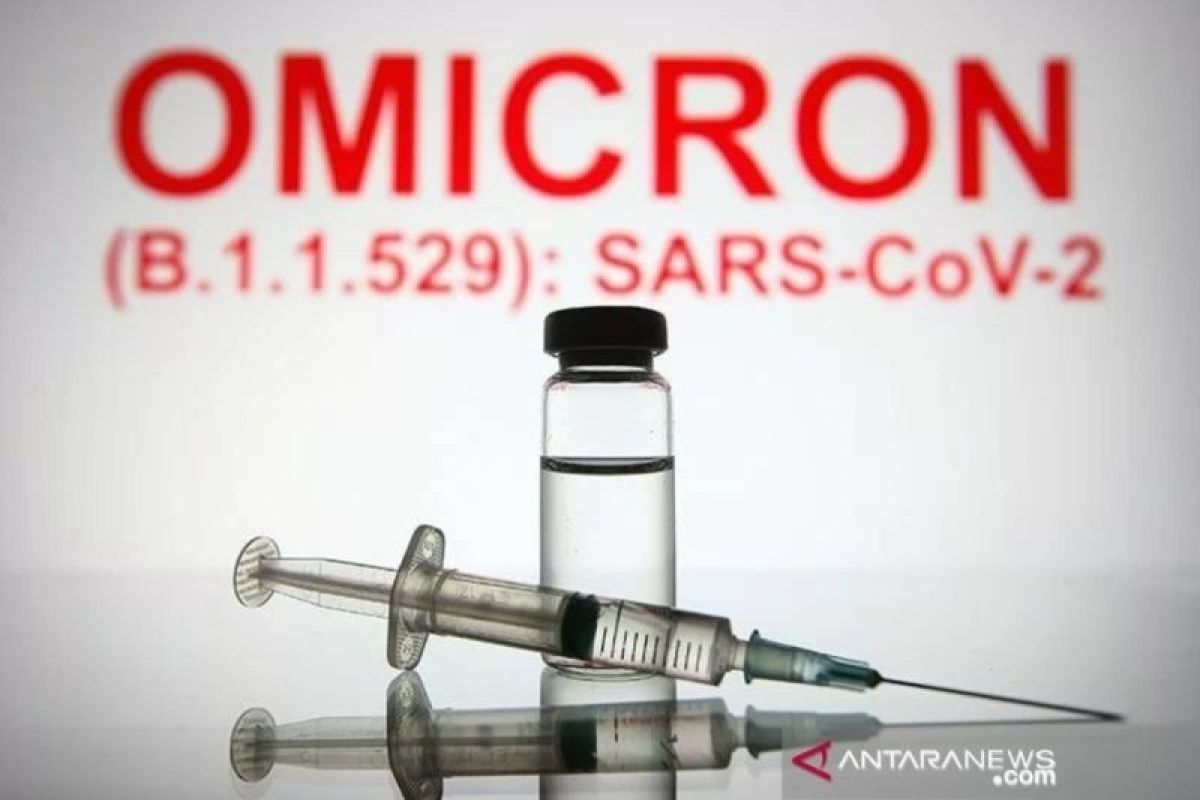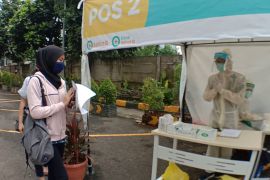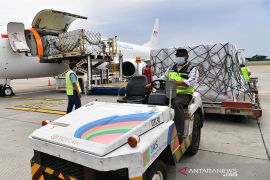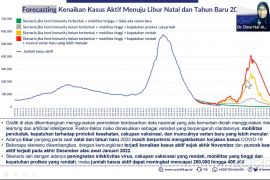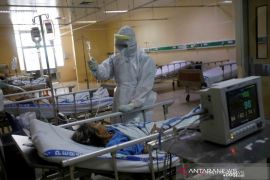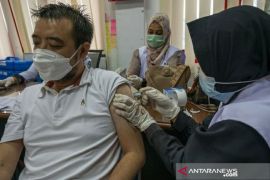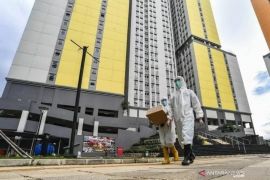I specifically appeal to all regional heads in areas where the second dose for the general public and elderly is still below 70 percent to speed up vaccination to provide protection against the Omicron variant. I remind you that omicron is our commonJakarta (ANTARA) - Indonesia is about to enter a phase wherein the daily count of COVID-19 cases is starting to increase.
The potential third wave due to the transmission of the new variant of COVID-19 called Omicron is estimated to take place between February and March 2022.
Although the Indonesian health system is prepared to tackle Omicron, public awareness in implementing health protocols must also be increased since it is the key to suppressing the spread of COVID-19.
Emergence of the third wave of COVID-19 is highly dependent on the people’s behavior during the pandemic.
Community mobility and compliance in the implementation of social distancing, washing hands, and wearing masks in the community are the key factors to face the third wave of COVID-19.
Earlier, several countries in Europe, the United States, and Africa had experienced the third wave of COVID-19 due to the Omicron variant.
Related news: Epidemiologist pushes for massive tracing to contain Omicron cases
The Omicron variant spreads at a much faster rate as compared to the Delta variant. This will certainly affect developments in terms of the pandemic.
Currently, four indicators of COVID-19 cases in the country have shown an increasing trend.
The first indicator is the number of positive cases that can likely start to increase. The number of daily positive cases on January 23, 2022, crossed the two-thousand mark, or more precisely reached 2,925 cases.
Earlier, Indonesia had successfully suppressed the number of positive cases to 100-200 per day.
The second indicator is the number of daily active cases that is also increasing. As of January 23, 2022, the number of active cases was recorded at 18,891.
Indonesia had succeeded in suppressing the number of daily active cases to reach four thousand.
Related news: Local gov'ts need to strengthen Omicron prevention: Epidemiologist
The third indicator is the positivity rate, or the proportion of people detected positive out of all those tested, that showed an upward trend, from 0.2 percent on January 1, 2022, and increasing to 1.79 percent on January 23, 2022.
The fourth indicator is the increase in bed occupancy ratio (BOR) of referral hospitals for COVID-19 patients to undergo isolation. The BOR is currently at around 25 percent on January 23 as compared to the previous 1.38 percent.
An increase in the number of these indicators shows an increase in the transmission of COVID-19 in Indonesia.
COVID-19 developments in the country are also an early alarm for the government and society to prepare for the third wave.
Related news: Health protocols essential despite hybrid immunity: expert
Anticipatory measures
As of January 23, some 1,161 cases of Omicron were recorded in Indonesia. The government, through the Ministry of Health, has also readied various mitigation measures as a precautionary step against the adverse effects of the third wave of COVID-19 by providing antivirus medicine.
Health Minister Budi Gunadi Sadikin stated that the government had readied anti-COVID-19 medicine called Molnupiravir manufactured by Merck and Paxlovid developed by Pfizer, each with 400 thousand tablets.
The anti-virus medicine has arrived in Indonesia and is ready to be used as a precautionary measure against the need for medicine amid the spike in COVID-19 cases.
Related news: Indonesia accelerates vaccination drive amid threat of Omicron spread
The medicine for COVID-19 treatment was originally divided into categories that can be purchased by the general public, procured through a doctor's prescription, and can only be given through hospital treatment.
In addition to providing anti-virus medicine, another mitigatory effort made by the government is by giving vaccine boosters to the community.
The government will also continue to pursue the administration of the second dose of vaccination for the general public and the elderly, especially in provinces, districts, and cities that have not yet reached 70 percent.
"I specifically appeal to all regional heads in areas where the second dose for the general public and elderly is still below 70 percent to speed up vaccination to provide protection against the Omicron variant. I remind you that omicron is our common enemy," Coordinating Minister for Maritime Affairs and Investment Luhut Binsar Pandjaitan emphasized.
A spokesperson for COVID-19 Vaccination from the Ministry of Health Dr Siti Nadia Tarmizi highlighted several tips that were continuously being applied to reduce cases.
The first is handling COVID-19 through detection by stepping up epidemiological tests, increasing the ratio of closely traced contacts, and boosting tracing and monitoring of the SARS-CoV-2 virus genome or genomic surveillance.
The other step is converting 30 to 40 percent of the hospital beds for COVID-19 handling, fulfilling oxygen supply requirements, medical devices and Human Resources (HR), deploying backup health workers, tightening hospital admission requirements, and utilizing centralized isolation.
The Indonesian government has striven to regulate special policies and strategies amid the COVID-19 pandemic. The community members, as important players in this matter, are expected to synergize with the government by continuing to adhere to health protocols and obeying the rules made for the common good to end the pandemic at the earliest.
Related news: Long wait for indigenous vaccine expected to end mid-year
Vaccination
In order to avoid the third wave of COVID-19 following the increase in Omicron cases, the government continues to work on completing vaccinations, especially for areas where the coverage of the first dose of vaccination has not reached 70 percent of the target.
In total, five regions -- West Sumatra, West Sulawesi, Maluku, West Papua, and Papua -- still require to accelerate vaccination.
The Indonesian government continues to encourage those regions to increase their vaccination rates. The sooner they complete vaccination, the faster herd immunity would be formed. In this way, the community can be protected from the threat of COVID-19 transmission.
Based on data from the COVID-19 Handling Task Force as of January 24, 2022, the first dose of the COVID-19 vaccine was administered to 181,377,519 people, or 87.09 percent, out of a total of 208,265,720 residents targeted for COVID-19 vaccination.
Meanwhile, 124,334,472 people had been fully vaccinated, or 59.70 percent of the target.
Related news: Health minister reviews COVID-19 vaccination for elderly in Bantul
On the other hand, the government also administered booster vaccination to increase the effectiveness of primary vaccines, or the first and second doses.
A booster vaccination is also meant to extend the period of protection to tackle the infectious nature of the COVID-19 virus mutations.
Booster vaccinations were able to increase individual protection and suppress the spread of COVID-19 in the country amid the spread of the Omicron variant.
The government is optimistic that the third wave of COVID-19 due to the Omicron variant can be quickly controlled through several anticipatory steps that had been readied.
In 2021, Indonesia had encountered various challenges in handling the COVID-19 pandemic, starting with the first spike in January and followed by a second surge in last July.
The government and the community must take notes in handling the pandemic to strengthen joint steps towards a productive and COVID-19 safe 2022.
Related news: Epidemiologist cautions on potential third wave of COVID-19 cases
Related news: Epidemiologist asks gov't to re-evaluate PPKM policy
Editor: Fardah Assegaf
Copyright © ANTARA 2022
